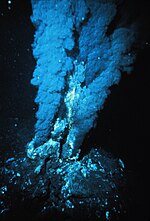Hydrogen isotope biogeochemistry (HIBGC) is the scientific study of biological, geological, and chemical processes in the environment using the distribution...
236 KB (30,181 words) - 14:35, 26 September 2024
Hydrogen (1H) has three naturally occurring isotopes: 1H, 2H, and 3H. 1H and 2H are stable, while 3H has a half-life of 12.32(2) years. Heavier isotopes...
15 KB (1,842 words) - 08:01, 26 October 2024
Environmental engineering science Geochemistry Geophysiology GEOTRACES Hydrogen isotope biogeochemistry IMBER Marine biogeochemical cycles Pedology Physical impacts...
13 KB (1,427 words) - 00:03, 30 November 2023
isotope biogeochemistry is the study of the distribution of sulfur isotopes in biological and geological materials. In addition to its common isotope...
76 KB (8,512 words) - 21:55, 22 September 2024
Hydrogen isotope biogeochemistry Allègre C.J., 2008. Isotope Geology (Cambridge University Press). Faure G., Mensing T.M. (2004), Isotopes: Principles and...
15 KB (1,818 words) - 23:14, 5 September 2024
Hydrogen sulfide is a chemical compound with the formula H2S. It is a colorless chalcogen-hydride gas, and is poisonous, corrosive, and flammable, with...
76 KB (7,939 words) - 09:52, 23 October 2024
on the isotope in question, the hydrogen cation has different names: Hydron: general name referring to the positive ion of any hydrogen isotope (H+) Proton:...
11 KB (1,502 words) - 04:52, 13 May 2024
signature Radiometric dating Isotope-ratio mass spectrometry Sulfur isotope biogeochemistry Urey–Bigeleisen–Mayer equation Drever, James (2002). The Geochemistry...
21 KB (2,408 words) - 19:03, 1 April 2024
Nitrogen-15 tracing is an important method used in biogeochemistry. The ratio of stable nitrogen isotopes, 15N/14N or δ15N, tends to increase with trophic...
41 KB (4,674 words) - 13:53, 28 June 2024
nuclide with equal numbers of protons and neutrons Cosmogenic Sulfur isotope biogeochemistry "Standard Atomic Weights: Sulfur". CIAAW. 2009. Prohaska, Thomas;...
9 KB (626 words) - 11:55, 10 October 2024
Methane clumped isotopes are methane molecules that contain two or more rare isotopes. Methane (CH4) contains two elements, carbon and hydrogen, each of which...
35 KB (4,336 words) - 22:41, 24 June 2024
Phosphate (redirect from Hydrogen Phosphate)
the various phosphates because of their key roles in biochemistry, biogeochemistry, and ecology, and their economic importance for agriculture and industry...
30 KB (2,582 words) - 02:29, 27 September 2024
Kinetic fractionation (category Isotope stubs)
Transient kinetic isotope fractionation Isotopic enrichment Isotopic ratio Kinetic isotope effect Hydrogen isotope biogeochemistry Carol Kendall (2004)...
4 KB (463 words) - 21:38, 30 September 2024
Marine biogeochemical cycles (redirect from Ocean biogeochemistry)
5194/hess-21-779-2017. Schlesinger, William H.; Bernhardt, Emily S. (2013). Biogeochemistry: an analysis of global change (3rd ed.). Waltham, MA: Academic Press...
118 KB (10,775 words) - 19:13, 17 October 2024
Schidlowski M, Hayes JM, Kaplan IR (1983). "Isotopic inferences of ancient biochemistries-Carbon, sulfur, hydrogen, and nitrogen.". In Schopf JW (ed.). Earth's...
61 KB (7,393 words) - 22:47, 29 October 2024
Hydrothermal vent (section Ocean biogeochemistry)
elements to the world's oceans, thus contributing to global marine biogeochemistry. Relative to the majority of the deep sea, the areas around hydrothermal...
116 KB (13,507 words) - 19:28, 20 October 2024
Trace metal stable isotope biogeochemistry is the study of the distribution and relative abundances of trace metal isotopes in order to better understand...
110 KB (13,535 words) - 10:02, 19 September 2024
position-specific isotope biogeochemistry studies these intramolecular variations, known as “position-specific isotope” and “site-specific isotope” enrichments...
35 KB (4,364 words) - 22:25, 5 January 2024
Cambrian (section Isotope excursions)
(significant variations in global isotope ratios) recognised. These excursions record changes in the biogeochemistry of the oceans and atmosphere, which...
89 KB (9,321 words) - 10:51, 25 October 2024
react with certain stable isotopes of carbon. The selective enrichment of one stable isotope over another creates distinct isotopic fractionations that can...
36 KB (4,271 words) - 20:26, 19 June 2024
measurements of the elemental and isotopic composition of a sample. The NanoSIMS is able to create nanoscale maps of elemental or isotopic distribution, parallel...
32 KB (3,819 words) - 18:47, 29 August 2024
concerned with the biochemistry of the Early Earth with a focus on isotope-biogeochemistry and the evidence of the earliest life processes in Precambrian...
57 KB (7,059 words) - 22:35, 1 September 2024
Urey–Bigeleisen–Mayer equation (category Biogeochemistry)
processes. Timeline of the Manhattan Project Isotope-ratio mass spectrometry Hydrogen isotope biogeochemistry Bigeleisen & Mayer (1947) contains the addendum:...
25 KB (2,369 words) - 15:00, 20 May 2024
Acetylene (section Hydrogenation)
Peter M. H. Kroneck and Martha E. Sosa Torres (ed.). The Metal-Driven Biogeochemistry of Gaseous Compounds in the Environment. Metal Ions in Life Sciences...
46 KB (4,385 words) - 19:30, 27 October 2024
– A synthesis project bringing together oceanographic data Hydrogen isotope biogeochemistry – Hypoxia (environmental) – Low environmental oxygen levels...
226 KB (32,625 words) - 04:19, 12 October 2024
heavy isotope relative to the reactants (low heavy isotope to light isotope ratio), and although this is not always the case, the study of isotope fractionations...
59 KB (6,037 words) - 21:56, 22 September 2024
doi:10.1021/ac60266a021. ISSN 0003-2700. Bian, Liangqiao (1994). Isotopic biogeochemistry of individual compounds in a modern coastal marine sediment (Kattegat...
8 KB (818 words) - 06:53, 14 July 2021
Molybdenum (section Isotopes)
100. Of these naturally occurring isotopes, only molybdenum-100 is unstable. Molybdenum-98 is the most abundant isotope, comprising 24.14% of all molybdenum...
75 KB (8,511 words) - 00:53, 29 September 2024


















